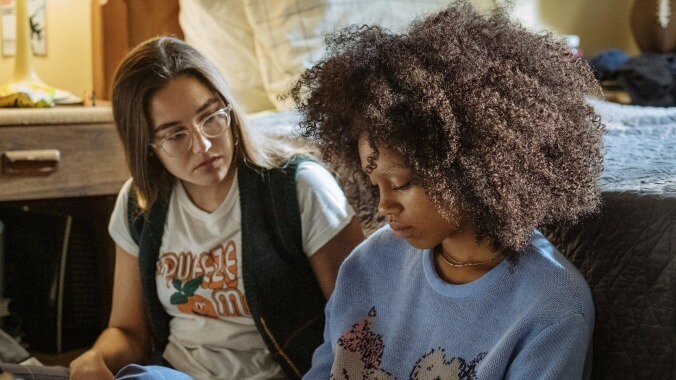Betty director Crystal Moselle on season 2’s “surprises” and search for community
Ahead of the Betty season 2 finale, director Crystal Moselle walks us through the Skate Kitchen crew's journey

HBO’s Betty maintained its easygoing charm and naturalistic performances in its second season, even as the COVID-19 pandemic intruded upon the world of the Skate Kitchen crew. Janay (Dede Lovelace) threw herself into her mutual aid efforts, and by the fifth episode, “Good Luck With That,” was organizing a canned food drive in the group’s new hangout. Camille (Rachelle Vintberg) found herself thrust into the role of an influencer, but as we head into the season-two finale, “The Let Out,” she looks ready to go rouge. Indigo (Ajani Russell) has been the most adrift this season; she’s still on the outs with her mom, so her friends make up her support network. Honeybear (Moonbear) dabbled in polyamory, only to find that her girlfriend Ash (Katerina Tannebaum) wanted to make a deeper dive. And Kirt (Nina Moran) became a guru to aimless young men, a role she struggles with more than ever in the finale.
Series creator Crystal Moselle took care to acknowledge the realities of the pandemic, incorporating masks and other safety guidelines onscreen and off. But the director wasn’t trying to go the route of Grey’s Anatomy or All Rise and produce a COVID episode—she tells The A.V. Club she sought to “reflect what we were experiencing. You have your pod of people; some people are irresponsible,” some of whom opt not to wear masks. In season two, the team “wanted to include some of that but not make it a plot point. We didn’t want the COVID part to be a plot point, but just to be the world that we’re living in and what we’re experiencing.”
Betty is undeniably a New York story, and as such, the show takes a look at how the pandemic affected the city in 2020. Grassroots organizers helped the most vulnerable, and protestors rose up against the powerful. In the premiere, the camera rolls past signs that read “White Silence Is Violence.” Asked how the show took these developments into account, Moselle notes “[T]he reality of the situation couldn’t be duplicated, and I didn’t even want to try to do that because I don’t know if we would do it justice.” Moselle says they didn’t set out to make “the whole season about” the calls for police accountability and reform, but this coming-of-age story absolutely recognizes that these teens are growing up at a time of great unrest. But Moselle and her team choose to focus on how the girls—like Janay, who sets up food deliveries for her neighbors—can shape their environment.
In its second season, Betty remains a poignant show about “women and men coming together for a greater good and helping people.” But, just as in our COVID reality, finding a place to convene was a challenge, for various reasons. It was important to Moselle to depict this community finding strength in each other: “One of the positive sides of what’s happened this past year is people did find community. You really connected deeper with your friends.” In the show, that meant showing the young women work “with the men to actually create the space that they can both inhabit. We were like, ‘How can they figure out how to create this space together?’”
But the series also acknowledges the ways that even teenage girls with a seemingly unshakeable bond can grow apart. We asked Moselle about the different journeys she mapped for her characters in season two. For Camille, the new season was “really about her getting in tune with what actually she’s about, and what makes her happy. She’s getting these great opportunities, but it’s not really who she is as a person. So, she’s having to stand up for herself and really be in tune with that.” Janay has been “spearheading this fight for the greater good. And through that, she starts creating a relationship with somebody she kind of doesn’t realize is something that could be good for her.” As for Kirt, she’s “taking the responsibility of helping men find their way and helping them understand women”—though the finale could challenge just how well she’s guided them. We watched Indigo hustle this season, while Honeybear explored different types of relationships.
“The Let Out” picks up on Halloween night, as Indigo, Camille, Janay, Kirt, and Honeybear gather for a costume party/food drive. There are some big developments in the finale, but some of Moselle’s favorite moments to film took place in the first half of the season. In “Blue Is The Warmest Threesome,” a tip from Indigo leads the friends to an unrented warehouse, which they quickly make their refuge. Moselle tells The A.V. Club she “really loved when they made it into the space and they’re all hanging out there at night with their phone flashlights and telling ghost stories. I always really love the moments where they get to improv and just turn the scene into something unique.” As she’s watched her young performers grow over the last five years, Moselle says they’re still capable of “nonstop surprises.” Whatever new challenges she’s set for her cast, they only “get more and more talented.”
Betty’s season-two finale, “The Let Out,” is directed by Crystal Moselle and written by Sabaah Folayan. It will air at 11 p.m. ET on HBO.